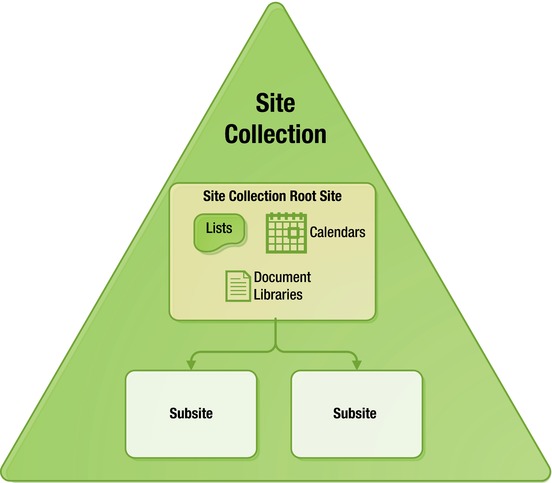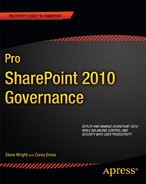Types of SharePoint Content Containers
A SharePoint server farm may contain many thousands of sites and millions of individual pieces of content. This content is logically organized from the user's perspective into sites, lists, and libraries. However, to effectively manage content, it is necessary to understand the physical layout as well.
The highest-level container within a SharePoint farm is the web application. A web application maps directly to an Internet Information Services (IIS) web site and indirectly to one or more Uniform Resource Locators (URLs). Web applications expose content through their URLs and control features such as the authentication of users to the site.
Each web application is associated with one or more content database. These are physical SQL Server databases that exist on a database server somewhere on the network. Depending on the importance of the content, these servers may exist in clustered or otherwise redundant configurations to ensure that they are always available. The content databases for a SharePoint farm can grow quite large. They contain all of the sites, pages, and documents that exist within the SharePoint environment. A web application can use more than one content database to allow for greater performance and scalability, but each content database can be associated with only a single web application. (See Figure 6-1.)

Figure 6-1. SharePoint content containers (farm-level view)
Each content database contains one or more site collections. Site collections are the logical boundary of a site in SharePoint. For example, the security configurations for sites cannot be inherited across a site collection boundary. The navigation controls that appear on SharePoint pages are designed, by default, to take their information only from a single site collection. This tends to isolate the content in one site collection from content in another unless an explicit accommodation is made to link them.
Site collections are also important in that they are used for two of SharePoint's most important management features: quotas and sandboxing. These are described in more detail in Chapter 13. These features allow farm administrators to control the resources and storage space that sites can be allocated.
Each site collection contains a single hierarchy of web sites. Each of these sites (sometimes called Webs) can contain a set of pages, lists, and libraries (see Figure 6-2). The lists and libraries contain the content elements that make up the site. Each site can be based on a different template, use different branding, and have separate security permissions.

Figure 6-2. SharePoint content containers (site collection view)
The containers illustrated in Figure 6-2 cover all of the content items normally found in a SharePoint server farm. There is one type of content that can be stored outside of SharePoint's content databases. Because SharePoint's content is stored in relational databases, SharePoint is very good at storing and using metadata describing the information it contains. It is not as efficient when storing large amounts of unstructured data such as audio and video files. These objects are called Binary Large Objects, or BLOBs. SharePoint 2010 has introduced the ability to leverage SQL Server's Remote BLOB Storage (RBS) mechanism to store this data.
When RBS is used to store large files, the metadata for the files remains in the content database for use by SharePoint; only the content of the file itself is moved elsewhere. The definition of a BLOB can vary depending on the needs of the system, but typically BLOBs
- Are larger than average MS Office document files
- Contain no data that is useful without accessing the entire file
- Cannot be updated, only replaced or deleted
When a SharePoint farm contains many BLOBs and they are stored in the content databases, the farm's performance can be compromised. In this case, it is best to move the BLOBs out of the content databases using RBS. Often BLOBs can be stored using less expensive disk storage. They can also be backed up separately from the content databases that reference them so that they can be managed using tools and procedures that are more appropriate for large binary files. More information about Remote BLOB Storage in SharePoint 2010 can be found on the Microsoft Developer Network (MSDN) at http://technet.microsoft.com/en-us/library/ee748649.aspx.
